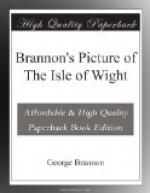Standing opposite Lymington, and once a place of considerable importance, having obtained a charter of franchises in the reign of Henry II: it is very clean and open,—and being situated in the neighbourhood of the most interesting coast scenery, is upon the whole an agreeable place, particularly for gentlemen partial to marine pleasures. Its chief support is derived from the shipping that anchor in its excellent roadsted, and the passengers to and from Lymington; there are three inns—the principal one (the George,) is a large ancient building, formerly the Governor’s house, where King Charles II was entertained by Sir Rt. Holmes on his paying the island a visit in 1667.—The Church has recently received the ornament of a new tower, and the interior boasts a good statue of the above-named Sir Robert. The Castle (as it is called), is a heavy, plain mass of building, constructed in the reign of Henry VIII to protect this entrance to the Solent Channel.
The village of NORTON is on the opposite side of the river, where there are several very respectable villas,—so sheltered by groves and shrubberies, that the whole neighbourhood presents the delightful appearance of a bold foreland completely shrouded in wood, even to the water’s edge.
Opposite Carey’s Sconce, half a mile west of Norton, is HURST CASTLE, built at the extremity of a long strip of shingly land stretching out from the Hampshire coast, which here contracts the width of the Solent Channel to less than a mile. Close by are two Light-houses, erected for the purpose of assisting ships to clear the passage through the Needles.
Four miles from Yarmouth we pass through SHALFLEET, a clean and populous village: the Church is next the road, of a heavy construction,—yet affording a good subject for a sketch. Northward is NEWTOWN, a very ancient borough; which was a populous place in the time of Richard II (when it was burned by the French, but soon afterwards rebuilt), and though now reduced to a few humble cottages, the course of its streets may yet be traced. It has a new church, of a neat design; and is noted for its extensive salterns, and convenient haven.—Previously to the passing of the Reform Bill in 1832, Yarmouth and Newtown each returned two members to parliament.
* * * * *
The Road by Calbourne and Carisbrooke.
The direct road from Freshwater-gate to Newport runs for the first three or four miles at the northern foot of the range of downs described at p. 89; presenting no object worthy of separate remark till we reach CALBOURNE, a considerable village, having a decent small inn. The pretty situation of its neat little Church and Parsonage,—the handsome mansion and luxuriant plantations of a first-rate seat called WESTOVER, close by,—with a small stream running through the grounds and in front of the neighbouring cottages,—altogether produce a very pleasing scene ...




